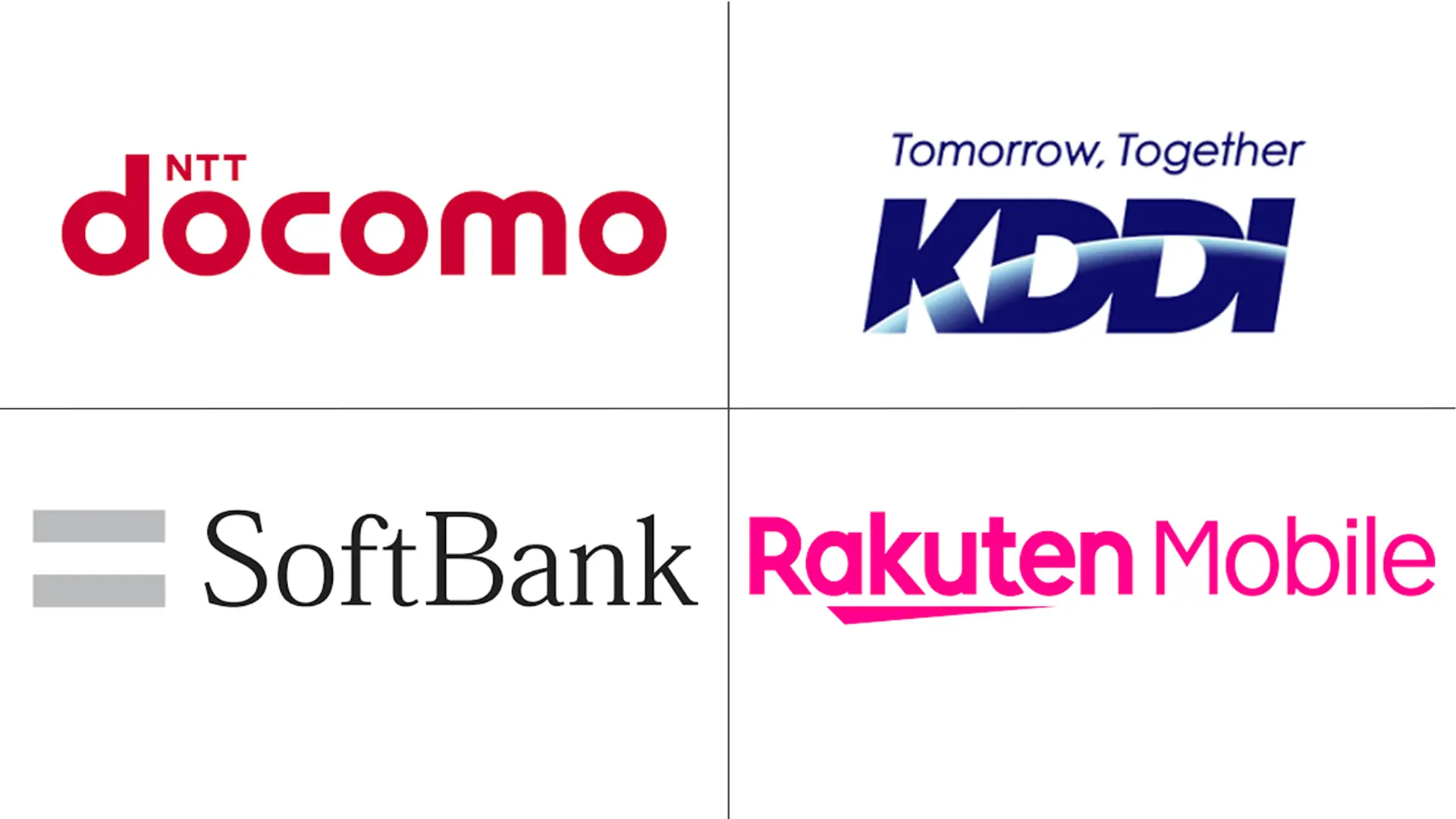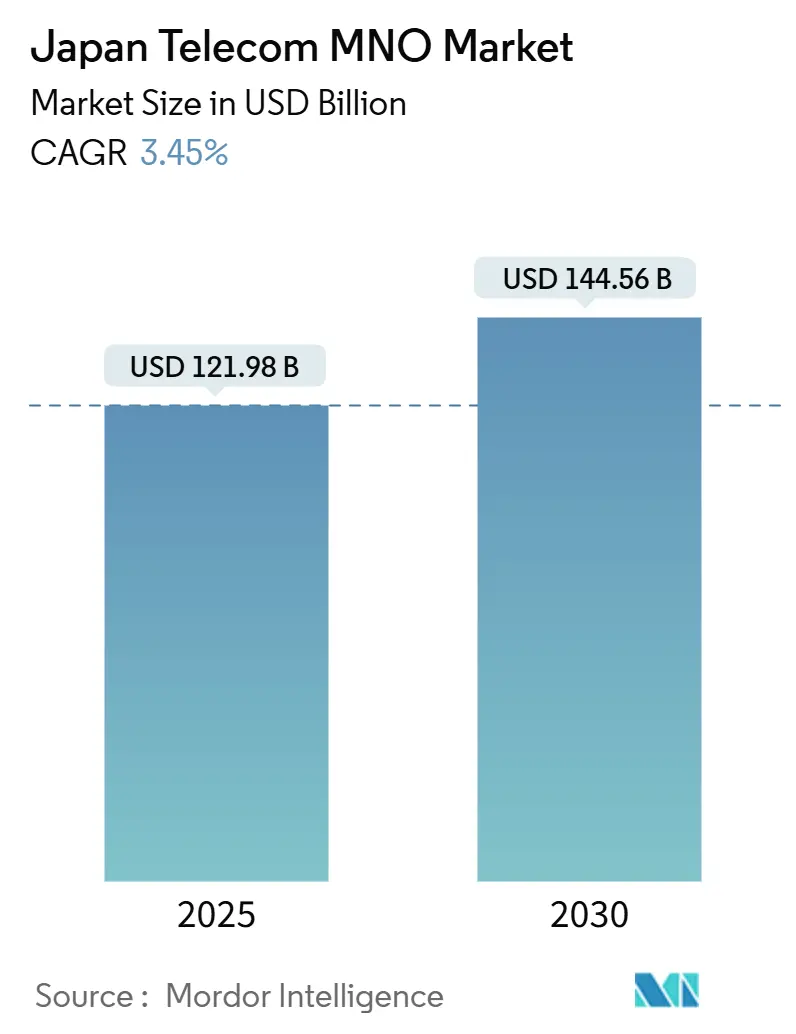
Japan Telecom MNO Market Analysis by Mordor Intelligence
The Japan Telecom MNO Market size is estimated at USD 121.98 billion in 2025, and is expected to reach USD 144.56 billion by 2030, at a CAGR of 3.45% during the forecast period (2025-2030). In terms of subscriber volume, the market is expected to grow from 228.30 million subscribers in 2025 to 266.25 million subscribers by 2030, at a CAGR of 3.12% during the forecast period (2025-2030).
Data-heavy applications now dominate traffic, private 5G campus networks begin to scale, and operators refocus on enterprise IoT to offset slowing consumer additions. Intensifying regulatory scrutiny on retail tariffs squeezes average revenue per user, yet bundled fixed-mobile offers, premium 5G tiers, and emerging AI-enabled services help defend profitability. Competitive advantages increasingly hinge on cloud-native architecture, AI-driven network automation, and energy-efficient radio access, all vital for maintaining margins while meeting sustainability targets. Japan’s digital-transformation (DX) policy adds tailwinds by accelerating industrial connectivity spending and public-sector smart-infrastructure projects.
Key Report Takeaways
- By service type, data and Internet services led with a 53.99% share of the Japan Telecom MNO market size in 2024, while IoT and M2M services are projected to grow at a 3.57% CAGR to 2030.
- By end-user, the consumer segment held 69.79% of the Japan Telecom MNO market share in 2024, whereas enterprise services are expected to expand at a 3.79% CAGR through 2030.
Japan Telecom MNO Market Trends and Insights
Drivers Impact Analysis
| Driver | (~) % Impact on CAGR Forecast | Geographic Relevance | Impact Timeline |
|---|---|---|---|
| 5G network roll-out and monetization | +1.2% | National; strongest in Tokyo, Osaka, Nagoya | Medium term (2-4 years) |
| Surging video-streaming and gaming data traffic | +0.8% | Urban corridors nationwide | Short term (≤2 years) |
| Government DX push accelerating enterprise IoT | +0.7% | Nationwide; manufacturing hubs | Medium term (2-4 years) |
| Fixed-mobile convergence boosting bundled ARPU | +0.5% | Suburban and rural zones | Long term (≥4 years) |
| Private 5G campus networks for smart factories | +0.4% | Aichi, Kanagawa, Osaka | Long term (≥4 years) |
| Open RAN cost efficiencies enabling new entrants | +0.3% | Nationwide | Medium term (2-4 years) |
| Source: Mordor Intelligence | |||
5G Network Roll-out and Monetization
Nationwide 5G coverage now exceeds 98% of population centers, reflecting regulators’ emphasis on ubiquitous connectivity rather than isolated speed peaks [1]NTT Docomo, “DOCOMO to Offer Japan's Fastest 5G SA Service for Downloads Up to 6.6 Gbps,” Docomo.ne.jp. NTT Docomo’s standalone 5G achieves 6.6 Gbps downloads, enabling ultra-low-latency industrial automation and cloud gaming. Operators nonetheless face a monetization gap: 5G subscriptions surpassed 69.8 million, yet service revenue growth lags capital outlays as consumers remain price sensitive. SoftBank’s AI-RAN partnership with Ericsson automates radio optimization, cutting OPEX while safeguarding user experience. Enterprise demand, particularly for time-critical manufacturing control, emerges as the primary engine for premium 5G revenue over the medium term.
Surging Video-Streaming and Gaming Data Traffic
Video accounts for 73% of mobile traffic, propelled by short-form platforms and higher-resolution streams; Japan’s paid video-distribution market rose to JPY 571 billion (USD 3.8 billion) in 2024 [2]Digital Content Association of Japan, “Video Distribution Market Research Report 2025,” Prtimes.jp. Generative-AI video creation inflates upstream traffic, forcing operators to augment backhaul capacity. Rakuten Mobile bundles unlimited data with U-NEXT to convert traffic growth into ARPU uplift and churn reduction.
Government DX Push Accelerating Enterprise IoT
Japan’s Basic Policy on Digital Society mandates smart-factory adoption to combat labor shortages. KDDI already manages over 10 million IoT lines spanning smart meters, connected cars, and industrial sensors [3]KDDI Corporation, “法人向けIoT累計回線数が1000万回線を突破,” Kddi.com. Private 5G trials, such as Obayashi’s autonomous dam-construction project, validate local 5G’s reliability for mission-critical control. The Japan Telecom MNO market consequently benefits from enterprise willingness to pay premium fees for deterministic connectivity and edge-cloud integration.
Fixed-Mobile Convergence Boosting Bundled ARPU
Households increasingly consolidate connectivity under one provider, responding to discounted bundles of fiber, mobile, pay-TV, and cloud storage. Academic analysis confirms partial substitution between mobile and fixed broadband, creating pricing leverage for converged plans. KDDI’s alliance with Lawson convenience stores adds 14,600 storefronts as in-person service hubs, reinforcing ecosystem stickiness [4]KDDI Corporation, “Mitsubishi Corporation, KDDI CORPORATION, Lawson, Inc. …,” Kddi.com .
Restraints Impact Analysis
| Restraint | (~) % Impact on CAGR Forecast | Geographic Relevance | Impact Timeline |
|---|---|---|---|
| Saturated subscriber base and shrinking population | -0.9% | Rural regions most exposed | Long term (≥4 years) |
| Price war and regulatory tariff cuts eroding ARPU | -0.6% | Nationwide | Short term (≤2 years) |
| Escalating energy costs pressuring network OPEX | -0.4% | Dense urban networks | Medium term (2-4 years) |
| Cybersecurity and data-sovereignty compliance risk | -0.3% | Enterprise segment | Medium term (2-4 years) |
| Source: Mordor Intelligence | |||
Saturated Subscriber Base and Shrinking Population
Mobile penetration reached 197 lines per 100 inhabitants in 2024, while Japan’s total population continued a multiyear decline to 125 million. An aging society, 28.7% are 65 or older, limits the uptake of cutting-edge mobile apps and devices. Operators counterbalance by courting youth segments and exporting know-how abroad; NTT Docomo’s new global subsidiary exemplifies the outward push.
Price War and Regulatory Tariff Cuts Eroding ARPU
Since 2021, the Ministry of Internal Affairs and Communications has demanded simpler, cheaper mobile plans, capping contract cancellation fees at USD 9 and pressuring carriers into sub-USD 20 monthly 20 GB bundles [5]Nikkei Asia, “Japan to Order $9 Cap on Wireless Cancellation Fees,” Asia.nikkei.com. Average smartphone prices under 20 GB are now among the world’s lowest, weighing on revenue even as data traffic climbs. Carriers respond with differentiated unlimited tiers, digital perks, and loyalty-point ecosystems to restore yield.
Segment Analysis
Data and Internet services generated 53.99% of Japan Telecom MNO market revenue in 2024, rising on the back of 4K video, cloud gaming, and real-time collaboration tools. The segment benefits from continued traffic growth despite pricing pressure, as operators transition from unlimited flat rates to speed- and latency-based tariff ladders.
Voice retains a safety-net role for emergency communication but now rides bundled offerings to arrest decline. Messaging revenue shrinks as OTT apps dominate, yet enterprise-grade A2P SMS for two-factor authentication remains resilient. IoT and M2M connectivity posts a 3.57% CAGR to 2030, driven by smart manufacturing and vehicle telematics solutions; its growing share elevates the overall Japan Telecom MNO market size through higher-margin, low-throughput connections. OTT content partnerships, such as Rakuten-U-NEXT, reinforce data-centric monetization while differentiating consumer propositions.
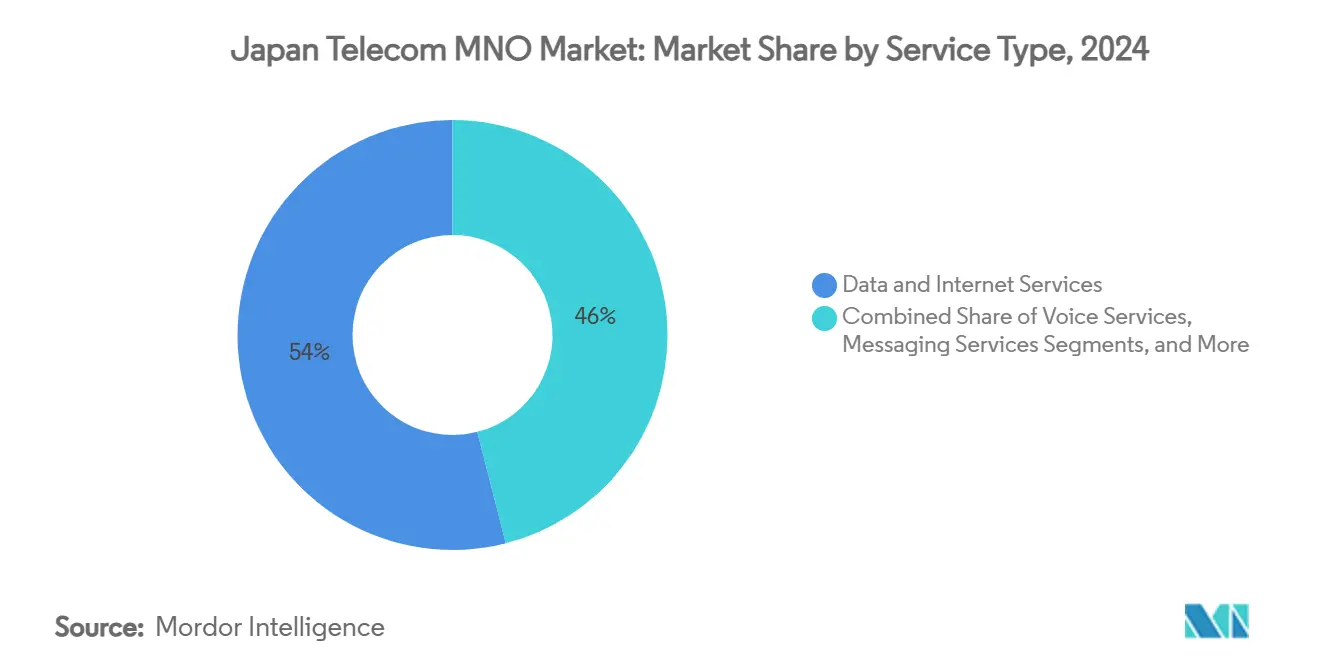
Note: Segment shares of all individual segments available upon report purchase
By End-User: Enterprises Offset Consumer Saturation
Consumers still accounted for 69.79% of the Japan Telecom MNO market size in 2024, but enterprise revenue is forecast to outpace at a 3.79% CAGR as firms digitize operations. Manufacturing, logistics, and public safety entities deploy private 5G and edge compute for latency-sensitive automation, raising average revenue per connection. KDDI’s business division recorded a 13.1% sales jump in fiscal-H1 2025, owing to IoT lines and digital-transformation consulting.
Consumer growth strategies now rely on AI-enabled personalization and multi-service bundles that increase share of wallet without expanding subscriber numbers. Senior-friendly plans address aging demographics, while youth-focused marketing aims to protect long-term ARPU trajectories.
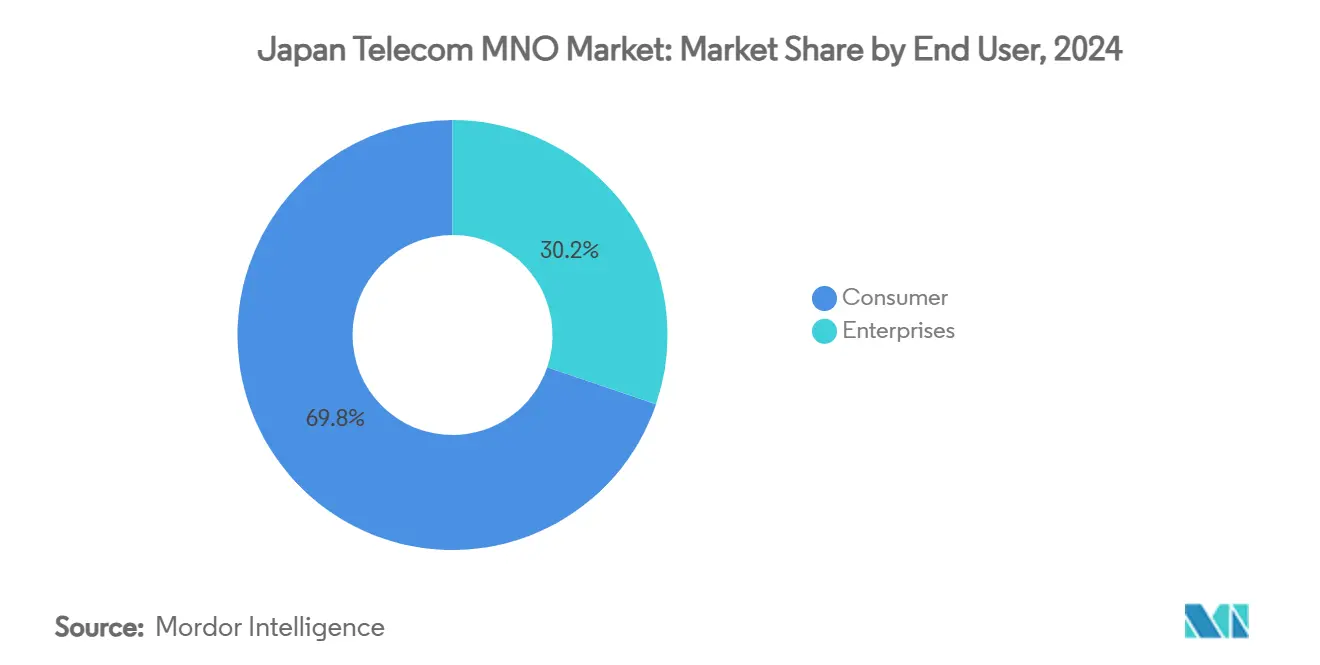
Geography Analysis
Tokyo, Osaka, and Nagoya concentrate two-thirds of Japan’s GDP, making them the first targets for 5G SA densification and network-slicing pilots geared to financial-trading latency and smart-manufacturing automation. Heavy user density elevates spectrum utilization, allowing operators to recoup capital faster and justify millimeter-wave deployments. Industrial corridors across Aichi and Kanagawa leverage private 5G for smart factories, supporting the Japan Telecom MNO market share in enterprise verticals.
Rural prefectures, facing depopulation, witness slower revenue growth yet receive continued 4G investment under universal-service mandates of the Telecommunications Business Act. Government subsidies for remote-area coverage and smart agriculture IoT partially offset unfavorable economics. Regional smart-city initiatives, from Hokkaido’s snow-management sensors to Kyushu’s disaster-response networks, extend incremental demand for low-bandwidth M2M lines. Overall geographic dispersion of advanced infrastructure mirrors economic concentration, with urban cores testing network-slicing and edge-compute while suburban and rural areas continue to migrate from 3G and legacy voice.
Competitive Landscape
The Japan Telecom MNO market remains oligopolistic: NTT Docomo, KDDI, SoftBank, and Rakuten Mobile collectively command all subscriptions, according to the Telecommunications Carriers Association. NTT Docomo exploits deep fiber assets and in-house R&D to pilot 6G in-network computing that fuses compute and connectivity for AI video analytics. KDDI diversifies via retail partnerships and multi-cloud consulting to hedge saturating mobile lines. SoftBank pursues AI-RAN to optimize spectrum and power utilization, trimming OPEX.
Rakuten Mobile differentiates with fully virtualized Open RAN, achieving 8 million users and targeting profitability through spectrum in the 700-MHz “platinum band”. Tower-sharing deals such as DigitalBridge’s acquisition of JTower accelerate passive-infrastructure outsourcing, lowering duplication and facilitating rural coverage. The Telecommunications Business Act, plus the pending abolition of the NTT Law, shapes competition rules, spectrum fees, and pricing oversight, compelling incumbents to balance compliance with innovation.
Japan Telecom MNO Industry Leaders
-
NTT Docomo, Inc.
-
KDDI Corporation (au)
-
SoftBank Corp.
-
Rakuten Mobile, Inc.
- *Disclaimer: Major Players sorted in no particular order
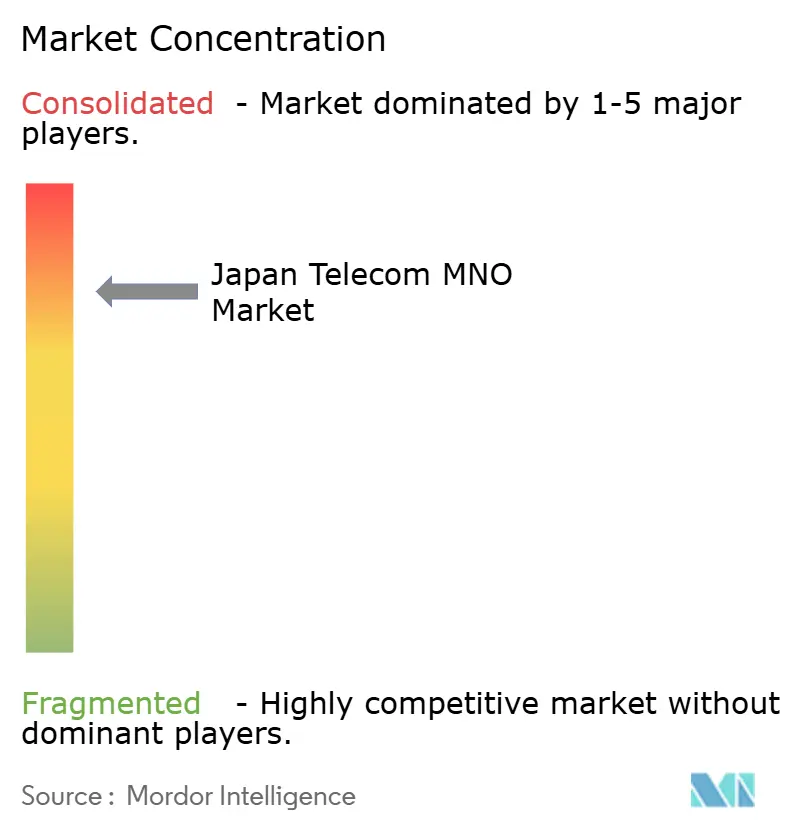


Recent Industry Developments
- March 2025: NTT and DOCOMO demonstrated in-network computing achieving 90% AI video-analysis accuracy, paving the way for 6G services.
- December 2024: NTT, KDDI, SoftBank, and Rakuten Mobile formed a joint disaster-response framework to improve network resilience.
- October 2024: SoftBank and Ericsson deepened AI-RAN collaboration for predictive-maintenance analytics.
- August 2024: Rakuten Mobile raised up to JPY 300 billion via a sale-and-leaseback of network assets with Macquarie to bolster its balance sheet.
- February 2024: SoftBank, NEC, and Broadcom completed RAN-virtualization validation under a unified O-RAN architecture.
Japan Telecom MNO Market Report Scope
The study provides an in-depth analysis of the telecommunication industry in Japan. Japan's telecom MNO market is segmented by services, which is further classified into voice services (wired, wireless), data and messaging services, and OTT and pay TV.
| Voice Services |
| Data and Internet Services |
| Messaging Services |
| IoT and M2M Services |
| OTT and PayTV Services |
| Other Services (VAS, Roaming and International Services, Enterprise and Wholesale Services, etc.) |
| Enterprises |
| Consumer |
| Service Type | Voice Services |
| Data and Internet Services | |
| Messaging Services | |
| IoT and M2M Services | |
| OTT and PayTV Services | |
| Other Services (VAS, Roaming and International Services, Enterprise and Wholesale Services, etc.) | |
| End-user | Enterprises |
| Consumer |


Key Questions Answered in the Report
How large is the Japan Telecom MNO market in 2025 and how fast will it grow?
It is valued at USD 121.98 billion in 2025 and is expected to rise at a 3.45% CAGR to USD 144.56 billion by 2030.
Which service category contributes the most revenue?
Data and Internet services deliver 53.99% of overall 2024 revenue, far surpassing legacy voice.
Which segment is expanding fastest?
IoT and M2M connectivity posts the highest growth, with a 3.57% CAGR projected to 2030.
How concentrated is market share among operators?
NTT Docomo, KDDI, SoftBank, and Rakuten Mobile collectively hold all mobile lines, with Docomo alone at 40.8%.
What is the main growth driver for enterprise revenue?
Accelerating adoption of private 5G and industrial IoT under Japan’s national DX policies spurs premium enterprise connectivity spending.
How is regulation influencing pricing?
The Ministry of Internal Affairs and Communications enforces low-cost plan mandates and caps early-termination fees, directly suppressing ARPU.
Page last updated on:
